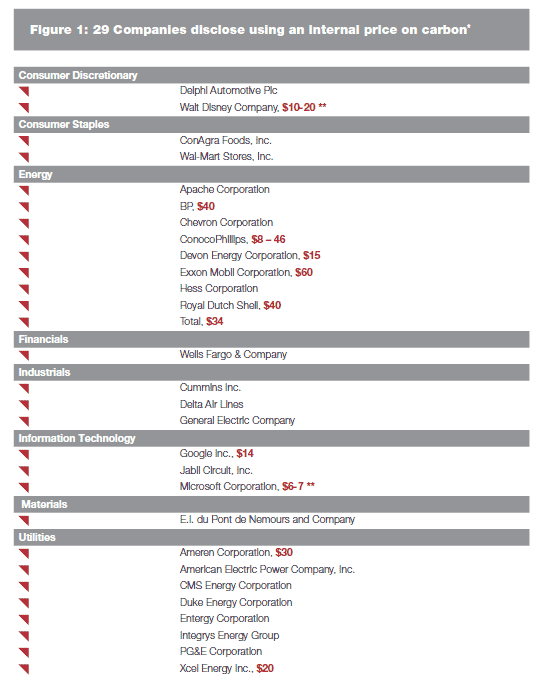A new report from the Carbon Disclosure Project (CDP) says a growing number of companies headquartered or having major operations in the US are in one form or another now putting an internal price on carbon emissions, though many of the critical details remain fuzzy.
CDP cites 29 major companies which say they have an internal carbon price of some kind, firms ranging from major utilities to Walmart, Jabil, GE and many more.
But there is a lot of variance in the practice, based on the reports many companies file annually with the CDP. Prices used, for example, range from $6-60 per metric ton of CO2, and companies use varying terminology, such as internal carbon price; shadow price, internal carbon fee, carbon adder, or carbon cost, to describe the concept.
It is unclear whether such a carbon price is actually truly assigned and used in decision-making, or whether it is simply presented as a variable to consider to understand the potential longer term cost aspects if and when the US places a price on carbon emissions in some fashion.
And that of course is the tricky question: if a company actually factors in a high carbon cost in making a decision today, it could potentially pay a big market price if no actual carbon cost ever comes, and the decision made is then not optimal under that scenario.
But of course, the opposite is true. If a company ignores the potential for future actual carbon costs, and makes for example supply chain network design decisions on that basis, it could be under a competitive disadvantage from high legacy carbon costs if the rules change to impose an actual cost per metric ton of emissions.
This is why the TheGreenSupplyChain.com has said from the beginning that it makes all the difference in the world in terms of impact whether or not a government mandated cost for carbon is ever implemented in the US or globally.
The graphic below from the CDP report shows what member companies say that are assigning a cost to carbon in some way, and in some cases disclose what that internal price is.

Source: Carbon Discosure Project
Of course, in some areas of the world, notably most of Europe and in the state of California in the US, a market-based price for carbon already exists. Right now in California, for example, that price is around $15.00 per ton - interestingly much lower than the price many US companies say they are using internally.
Countries such as China, India and dozens of others of course have no carbon costs, as with the rest of the US currently. Australia implemented a carbon tax in 2012, but its new prime minister campaigned against the unpopular measure and has introduced legislation to undo it.
This is sure to be a future battleground if some nations have high costs for carbon emissions and others don’t, fueling calls for things like “carbon tariffs” to level the playing field. It is also related to calls from developing nations for huge funding from richer economies so that they can supposedly move to a post-carbon future without the benefit of the carbon heavy phase from which developed economies benefited.
There were some interesting examples. Disney, for example, says “To achieve our long-term goal of 'zero net direct GHG emissions," the Company strives to reduce direct emissions and invest in high-quality carbon offset projects. The costs of the carbon offset projects are charged back to individual business units at a rate proportional to their contribution to the Company’s overall direct emissions footprint. Thus, our businesses are now exposed to an internal carbon price.”
It continues: "The 'Climate Solutions Fund' is the name given to the Company’s internal carbon pricing program. This program essentially places an internal tax on carbon emissions, giving business units an incentive to reduce their carbon emissions. The program also places a known cost on carbon emissions, which allows the business segments to more accurately determine cost effective efficiency projects to undertake."
Walmart said that "When we were making key environmental business decisions, the existing simple payback model of a specified number of years had to be rethought to ensure we were making the right investments. ASDA [a Walmart affiliate] was one of the first U.K. retailers to embed a shadow cost of carbon in all carbon mitigation investment decisions. The actual price we set is confidential, but flexible, to allow it to change with time as external factors evolve, and thus ensure our appraisal model remains world class."
But Walmart noted that of course, what the actual cost of carbon might be in the future is unknown, and dependent on the types of programs (cap and trade, carbon tax, etc.) and their details. In effect, all you can do right now is to take your best guess, though scenario analysis at different carbon costs levels would seem prudent.
Is your company including carbon costs in terms of making business and supply chain decisions? Should companies be doing this? Let us know your thoughts at the Feedback button below.

|